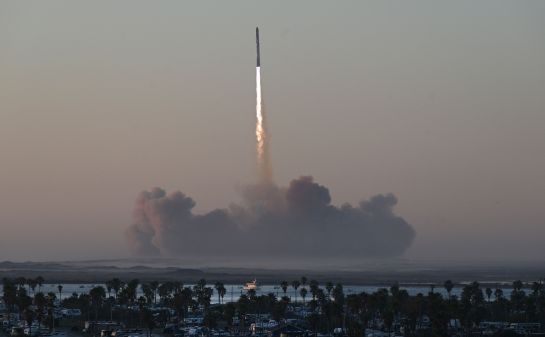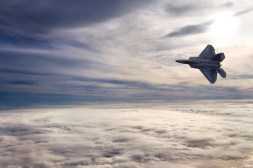
Lt. Gen. Michael Basla will become the Air Force’s chief information officer when Lt. Gen. Bill Lord retires this summer, the Air Force confirmed to FedScoop.
Basla is currently vice commander of the Air Force Space Command at Peterson Air Force Base in Colorado, where he assists the commander in organizing, equipping, training and maintaining mission-ready space and cyberspace forces and capabilities for North American Aerospace Defense Command, U.S. Strategic Command. He also supports the other functional and geographic combatant commands with missile warning, positioning, navigation and timing, communications and cyber capabilities.
Prior to his current assignment, Basla was vice director for C4 Systems for the Joint Chiefs of Staff at the Pentagon.
Watch Basla address the University of Albany football team where he played offensive tackle as an undergraduate:
Lord has served as Air Force CIO since July 2009 and will officially retire from his position on July 31.
Among his major accomplishments is building a communications framework for network-centric operations that will help the Defense Department in its quest for interoperability.
Lord also designated a federated Air Force enterprise architecture that was the first to be certified by the Defense Department’s Architecture and Standards Review Group, along with leading the development of a comprehensive aerial layer network that will support joint, real-time communications on the battlefield.
Lord pushed the development of department-wide IT standards that will establish the price of admission for joint warfighting and industry partnerships in cyberspace.
In 2011, he took part in FedScoop’s FedMentors program:
Basla’s bio:
Lt. Gen. Michael J. Basla is Vice Commander, Air Force Space Command, Peterson Air Force Base, Colo. He assists the commander in organizing, equipping, training, and maintaining mission-ready space and cyberspace forces and capabilities for North American Aerospace Defense Command, U.S. Strategic Command and the other functional and geographic combatant commands with missile warning, positioning, navigation and timing, communications and cyber capabilities. The command oversees Air Force network operations; manages a global network of satellite command and control, communications, missile warning and space launch facilities; and is responsible for space system development and acquisition. The command comprises more than 46,000 space and cyberspace professionals assigned to locations worldwide and deployed to an additional 35 global locations. General Basla also directs and coordinates the activities of the headquarters staff.
General Basla is a native of Syracuse, N.Y., graduating from Bishop Grimes High School. He received his commission in 1979 as a distinguished graduate of Officer Training School. General Basla has served in five operational communications units including commands at detachment, squadron and group levels. He has extensive joint experience including a tour as Director for C4 Systems, Joint Task Force Southwest Asia in Saudi Arabia where he delivered integrated network operations in support of United Nations security resolution enforcement against Iraq. He has served on the staffs of the Joint Staff, U.S. Transportation Command, Headquarters U.S. Air Force, Air Mobility Command and Air Force Communications Command. In 2005, General Basla received the Eugene M. Zuckert Award, which honors outstanding management achievements by a Department of the Air Force Manager.
Prior to his current assignment, he was Vice Director for C4 Systems, Joint Staff, the Pentagon, Washington, D.C., where he supported the Director of C4 Systems in supporting the Chairman of the Joint Chiefs of Staff in carrying out his duties as principal adviser to the President and Secretary of Defense and developing and providing guidance to the combatant commands on C4 systems and information capabilities as key enablers of combat forces.
EDUCATION 1975 Bachelor of Science degree in mathematics, University of New York, Albany 1984 Squadron Officer School, Maxwell Air Force Base, Ala. 1985 Master of Science degree in teleprocessing science, Air Force Institute of Technology, University of Southern Mississippi, Hattiesburg 1990 Air Command and Staff College, by correspondence 1992 Distinguished graduate, College of Naval Command and Staff, Naval War College, Newport, R.I. 1996 Industrial College of the Armed Forces, National Defense University, Fort Lesley J. McNair, Washington, D.C. 1998 Seminar XXI, Foreign Political and International Relations, Massachusetts Institute of Technology, Cambridge 2003 Senior Executive Fellow, John F. Kennedy School of Government, Harvard University, Cambridge, Mass. 2009 Senior Joint Information Operations Course, Air University, Maxwell AFB, Ala.
ASSIGNMENTS 1. March 1979 – March 1980, student, Basic Communications-Electronics Course and Communications Computer Programming Course, Keesler AFB, Miss. 2. March 1980 – November 1982, Automatic Digital Network systems analyst, later, Chief, AUTODIN Switching Center, 2049th Communications Group, McClellan AFB, Calif. 3. November 1982 – February 1984, Commander, Detachment 2, 2186th Communications Squadron, Menorca Radio Relay Location, Spain 4. May 1984 – March 1985, student, Telecommunications Staff Officer Course, Keesler AFB, Miss. 5. March 1985 – August 1985, student, Air Force Institute of Technology, University of Southern Mississippi, Hattiesburg 6. August 1985 – June 1988, command and control systems integrator, later, aide-de-camp to the Commander, Air Force Communications Command, Scott AFB, Ill. 7. July 1988 – July 1991, Commander, 2143rd Communications Squadron, and Deputy Commander for Communications-Computer Systems, 26th Training Wing, Zweibrucken Air Base, Germany 8. August 1991 – June 1992, student, Naval College of Command and Staff, Naval War College, Newport, R.I. 9. July 1992 – June 1995, action officer, Directorate of C4 Systems (J6), Joint Staff, the Pentagon, Washington, D.C. 10. June 1995 – June 1996, student, Industrial College of the Armed Forces, National Defense University, Washington, D.C. 11. July 1996 – July 1998, assistant for senior officer matters, later, Chief, Force Management Division, Deputy Chief of Staff for Communications and Information, Headquarters U.S. Air Force, Washington, D.C. 12. July 1998 – April 2000, Commander, 96th Communications Group, Eglin AFB, Fla. 13. April 2000 – May 2001, Director, C4 Systems (J6), Joint Task Force Southwest Asia, Riyadh, Saudi Arabia 14. June 2001 – April 2002, Director of Information Technology Enterprise Operations, Deputy Chief of Staff for Communications and Information, Headquarters U.S. Air Force, Washington, D.C. 15. May 2002 – June 2004, Director of Communications and Information, Headquarters Air Mobility Command, Scott AFB, Ill. 16. June 2004 – December 2005, Deputy Director, Operational Support Modernization Program, Deputy Chief of Staff for Warfighting Integration, Headquarters U.S. Air Force, Washington, D.C. 17. December 2005 – June 2007, Director, Command, Control, Communications and Computer Systems (TCJ6), U.S. Transportation Command, Scott AFB, Ill. 18. June 2007 – August 2009, Vice Director, Command, Control, Communications and Computer Systems (VJ6), Joint Staff, the Pentagon, Washington, D.C. 19. August 2009 – present, Vice Commander, Air Force Space Command, Peterson AFB, Colo.
SUMMARY OF JOINT ASSIGNMENTS 1. July 1992 – June 1995, action officer, Directorate of C4 Systems (J6), Joint Staff, the Pentagon, Washington, D.C., as a major and lieutenant colonel 2. April 2000 – May 2001, Director, C4 Systems (J6), Joint Task Force Southwest Asia, Riyadh, Saudi Arabia, as a colonel 3. December 2005 – June 2007, Director, C4 Systems (TCJ6), U.S. Transportation Command, Scott AFB, Ill., as a brigadier general 4. June 2007 – August 2009, Vice Director, C4 Systems (VJ6), Joint Staff, the Pentagon, Washington, D.C., as a brigadier general and major general
MAJOR AWARDS AND DECORATIONS Defense Superior Service Medal with two oak leaf clusters Legion of Merit with oak leaf cluster Defense Meritorious Service Medal Meritorious Service Medal with four oak leaf clusters Air Force Commendation Medal
PROFESSIONAL MEMBERSHIPS AND ASSOCIATIONS Outstanding Young Men of America Life member, Air Force Association Life member, Armed Forces Communications and Electronics Association Life member, Naval War College League
EFFECTIVE DATES OF PROMOTION Second Lieutenant March 20, 1979 First Lieutenant March 20, 1981 Captain March 20, 1983 Major Dec. 1, 1988 Lieutenant Colonel March 1, 1994 Colonel Sept. 1, 1998 Brigadier General Sept. 1, 2005 Major General Nov. 24, 2008 Lieutenant General March 2, 2011




